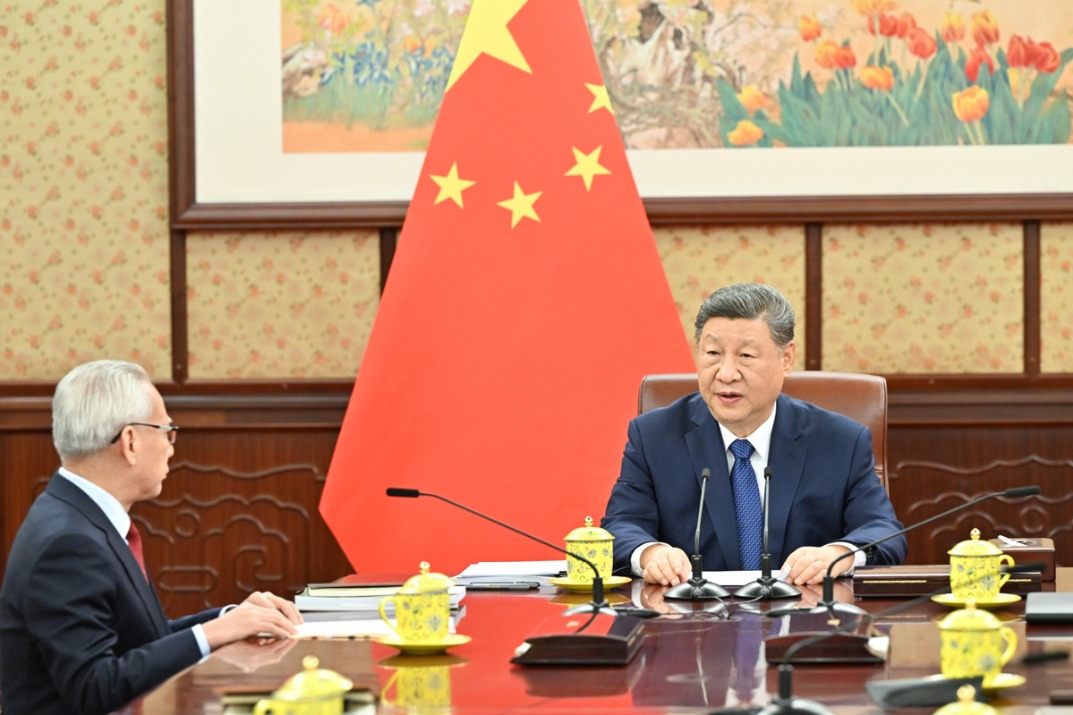IN BRIEF (Page 2)

| A tug of war tests strength and endurance during an aquatic sports gathering at a wetland park in Enshi, Hubei province, on Aug 29. A range of activities, including dragon boat racing, aquatic volleyball and kayaking, were held during the three-day event, which began on Aug 27. More than 2,200 contestants competed. Song Wen / For China Daily |
Pet boom raises demand for veterinarians
More students in China are choosing veterinary medicine as a career, thanks to rising salaries and the growing demand for animal care, according to industry sources. Up to 10,000 students graduate with majors in the field every year in China, but the country is still short of more than 1 million vets, says Xiong Fuqiang, deputy Party chief of Nanjing Agricultural University's veterinary medicine school. "Few students, especially female students, wanted to become vets in the past due to a heavy workload, low salary and bad working environment. But we have had good applicants in the past two years, and more than 60 percent of them are female." He says the average starting salary for veterinary graduates is 4,000 yuan ($607; 508 euros; £470) a month, and in three years their earnings can surpass 10,000 yuan, higher than the salaries of many other majors.
To ease load, more IP courts planned
Three IP courts were created in Beijing, Shanghai and Guangdong province in 2014 under judicial reforms encouraged by the central leadership, but more such courts are needed, according to a report by the Supreme People's Court. The report has been submitted to the bimonthly session of the Standing Committee of the National People's Congress, China's top legislature, for review. "We're accumulating case hearing experience of the three IP courts and preparing to set up more such courts at the right time to satisfy people's increasing legal demand for professional IP trials and to boost our country's technology innovation," says Zhou Qiang, president of the top court. But the exact time of the expansion and how many new courts are expected to be set up was not released in the report.
More work urged on nanotech applications
China's nanotechnology field is developing at an unprecedented pace, but it still needs a boost in turning research into the reality of producing groundbreaking works, China's top scientists say. In 2016, Chinese scientists produced about 33 percent of the world's total science papers on nanotechnology, a fivefold increase since 1997, according to a collaborated white paper published by the Chinese Academy of Sciences, China's National Center for Nanoscience and Technology and Springer Nature, an international science journal publisher. China also has become the world's largest nano-related patent contributor since 2008, with 209,344 patent applications over the past two decades. This is twice as many as that of the United States, the second-largest contributor, the white paper said. However, China still needs to put in more effort and investment to turn nanotechnology research into actual applications, says Bai Chunli, president of the Chinese Academy of Sciences.
Graft agency receives 9.5% more reports
Discipline authorities received 1.32 million reports of suspected graft and punished 210,000 people in the first half of this year, according to the country's top discipline watchdog, with reports up by 9.5 percent and punishments up by 29 percent year-on-year. A total of 256,000 cases were filed for investigation from January to June, compared with 193,000 during the same period last year, says Yang Xiaodu, minister of supervision and deputy head of the Communist Party of China's Central Commission for Discipline Inspection. Yang says that since the new leadership was elected in late 2012, China's anti-graft campaign has achieved great success. The spread of corruption has stopped, and a crushing momentum against graft has taken shape, he says.
Online charity event proves to be popular
A charitable art sale on WeChat on Aug 29 collected 6.6 million yuan ($1 million; 839,000 euros; £776,000) in four hours. Many WeChat users shared their newly bought paintings on their personal pages. Some even changed their phone's wallpaper. The works were painted by autistic people and sold via Tencent's charitable platform. Money collected will be donated to a project called "Enlighten life with art", which aims to eliminate social prejudice and help people with disabilities such as autism, cerebral palsy and Down syndrome. Altogether, 36 works of art were available from artists 11 to 37 years old, and buyers could save a digital copy. The project began on Aug 17, but discussion heated up in earnest on Aug 29 on WeChat, a major social media platform. WeChat is owned by Tencent. Donations since the project began totaled more than 15 million yuan. About 5.8 million people participated. By noon on Aug 29, 2 million people had participated and donated 8.4 million yuan.
Forest farm plants seeds of success
China plans to use its experience in green projects like Saihanba - the nation's largest man-made forest - to build similar forest farms in ecologically fragile regions to fight desertification, the National Development and Reform Commission said. The Saihanba Forest Farm, 150 kilometers from Beijing in Hebei province, forms a natural barrier between the capital and the sandstorms that often blow in from the north. In addition to its tree coverage, the forest farm has developed in a sustainable way, with economic growth relying on tourism, tree seeding, wind power generation and logging. The green sectors brought in 100 million yuan ($15 million; 12.7 million euros; ��11.7 million) last year, outweighing the revenue from past logging operations, data from the commission showed.
Millions more rise out of poverty
China lifted about 14 million people out of poverty from 2012 to 2016, and the annual per capita income in impoverished rural areas has grown by 10.7 percent per year, according to a report from the State Council released on Aug 29. The report on poverty relief work was submitted for review at the five-day bimonthly session of the Standing Committee of the National People's Congress, which opened on Aug 28.
Policies help rural college candidates
Chinese colleges and universities have admitted 100,000 students from rural and underdeveloped areas this year, a 9.3 percent increase over 2016, according to the Ministry of Education. The country has implemented favorable college entrance policies, including enrollment programs at national, regional and university levels, to enable more students from rural and poor areas to get a university education. In the national program, the requirements to be accepted at key colleges and universities - those affiliated with central ministries and provincial governments - have been lowered for students from impoverished counties.
Aerospace contractor launches hyperloop R&D
China Aerospace Science and Industry Corp, one of the nation's major space contractors, announced that it has launched research and development into a futuristic ultrafast transportation system, popularly known as a hyperloop, in Wuhan, Hubei province, on Aug 30. The CASIC hyperloop will be a maglev - magnetic levitation - line on which a streamlined, engineless train will travel on partly elevated tubes or tunnels at superfast speeds reaching 1,000 kilometers per hour, according to a news release published by the company at the Third China International Commercial Aerospace Forum in Wuhan. CASIC is the first Chinese enterprise and the world's third, following the United States' Hyperloop Transportation Technologies and Hyperloop One, to start developing a hyperloop system capable of reaching 1,000 km/h. The project will benefit from the company's experience in systems engineering and supersonic vehicles, CASIC says.
Renminbi rises strongly against US dollar
China's central bank raised the yuan's official central parity rate to 6.6102 per US dollar on Aug 30, the strongest level since mid-August 2016. Analysts, however, expect that the currency will not continue to rise as strongly in the coming months if the dollar rebounds. The yuan's midpoint rate, set by the People's Bank of China and seen as a guide for market transactions, was 191 basis points higher than on Aug 29, when it already had risen by 60 basis points over Aug 28. The yuan has risen by about 5 percent against the dollar since the start of the year."The strengthening is built on China's economic fundamentals," says Zhao Qingming, chief economist at the China Financial Futures Exchange. "The trend is clear that the Chinese economy has started to stabilize and improve while the US economic recovery seems to be rather fragile."
Reforms to remove innovation barriers
China will step up reform to support innovation by removing barriers to entrepreneurship and innovation. The decision was made at a State Council executive meeting presided over by Premier Li Keqiang on Aug 30. The meeting decided that the government will roll out a host of reform measures that have been tested in eight areas, including the Beijing-Tianjin-Hebei region, Shanghai and the Pearl River Delta, since June 2016. Among them: Eligible foreign students with academic backgrounds equal to or above master's degree level will be able to apply for a work permit or a work-related residence permit. The one-stop application and issuance of work permits for foreign experts will also be made available nationwide.
(China Daily Africa Weekly 09/01/2017 page2)
Today's Top News
- Opening of new gateway can help foster global economic and trade cooperation
- The farmer, the snake and Japan's memory hole
- Crossing a milestone in the journey called Sinology
- China-Russia media forum held in Beijing
- Where mobility will drive China and the West
- HK community strongly supports Lai's conviction































